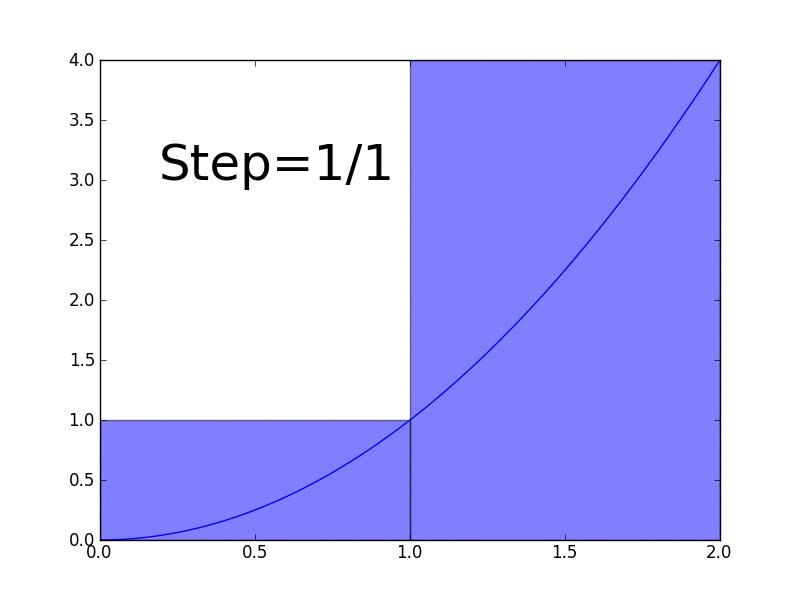An integral is useful for finding the area underneath a function. Let \(f(x)\) be any arbitrary function such that it is smooth and continuous at every point. To find the area underneath \(f(x)\), we must go through several steps. First, we'll start off by drawing an \(n\) (where \(n\) is any positive integer) number of rectangles of equal width underneath \(f(x)\) as illustrated in Figure 1. What is the total area of all the rectangles? The area of the first rectangle is \(A_1=f(x_1)(x_2-x_1)\); the area of the second rectangle is \(A_2=f(x_2)(x_3-x_2)\); and the area of the \(n\)th rectangle is
\(A_n=f(x_n)(x_{n+1}-x_n)\). Since every rectangle has the same width, it follows that \(x_2-x_2=x_3-x_2=x_{n+1}x_n= Δx\). To find the total area of all the rectangles, let's add up the area of each rectangle:
Figure 1
$$A=A_1+A_2+...+A_n=f(x_1)Δx+ f(x_2)Δx+...+ f(x_n)Δx\sum_{i=1}^nf(x_n)Δx.\tag{1}$$
As you can see visually in the animation in Figure 2, as the number of rectangles \(n\) increases, the area \(A\) becomes closer and closer to equaling the exact area underneath the curve. Using Equations (1), let's take the limit as \(n→∞\) to get
$$\lim_{n→∞}\sum_{i=1}^nf(x_n)Δx.\tag{2}$$
Figure 2. The approximate area, \(\sum_{i=1}^nf(x_n)Δx\), underneath the curve \(y=x^2\) becomes closer and closer to the exact area underneath the curve as the number \(n\) of terms increases.
Let's review the notion of a limit that we covered in an earlier lesson. The value that the limit, \(\lim_{z→c}g(x)\), is equal to is the value that \(g(x)\) gets closer and closer to while \( z→c\). Take for example the limit, \(\lim_{x→2}x^2\), that we looked at in a previous lesson. The value that this limit is equal to is the value that \(x^2\) gets closer and closer to as \(x→2\). We showed that this value is \(4\). Similarly the value of the limit, \(\lim_{n→∞}\sum_{i=1}^nf(x_n)Δx\), is the value that \(\sum_{i=1}^nf(x_n)Δx\) gets closer and closer to equaling the exact area underneath the curve \(f(x)\). Thus, the limit must equal the area underneath \(f(x)\) and
$$\text{Area underneath f(x)}=\lim_{n→∞}\sum_{i=1}^nf(x_n)Δx.\tag{3}$$
Let's see if there is a simpler way of rewriting the right-hand side of Equation (3). Not to sound too annoyingly repetitive but, again, the limit \(\lim_{n→∞}\sum_{i=1}^nf(x_n)Δx\) is equal to the thing that \(\sum_{i=1}^nf(x_n)Δx\) gets closer and closer to equaling as \(n→∞\). But if you think about it for a moment, the following must be true: if \(n→∞\), then the number \(n\) of the terms \(f(x_i) Δx\) is getting closer and closer to infinity; thus, the finite sum \(\sum_{i=1}^n\) (of an \(n\) number of terms) is getting closer and closeer to becoming an infinite sum. Let's represent an infinite sum (that's to say, a sum of infinitely many terms) by the symbol "\(∫\)." As \(n→∞\), it is also true that the width \(Δx\) is getting closer and closer to becoming infinitely small. Let's represent an infinitely small \(Δx\) by the symbol " \(dx\) ."
With all that said, I'd like to just make a few remarks about the variable \(x\), then about the expression \(\int{f(x)dx}\), and then we'll see how that ties in with our discussion of the limit \(\lim_{n→∞}\sum_{i=1}^nf(x_n)Δx\). Since \(x\) is a continuous variable, it can take on an infinite number of values: such as the numbers \(2\), \(π\), \(3.001\), \(3.00001\), \(3.00000001\), etc. Thus, there are an infinite number of y-values along the curve \(f(x)\): including \(f(2)\), \(f(π)\), \(f(3.001\), etc. The term \(f(x)dx\) is the area of an infinitely skinny rectangle; and the expression \(\int{f(x)dx}\) is the sum of an infinite number of the terms, \(f(x)dx\). \(\int{f(x)dx}\) gives the infinite sum of all the areas \(f(x)dx\) of (infinitely) skinny rectangle. What is \(\sum_{i=1}^nf(x_i)Δx\) getting closer and closer to equaling as \( n→∞\)? Well, clearly its getting closer and closer to being an infinite sum, and \(x_i\) and \( Δx\) are approaching \(x\) and \(dx\). Thus, the limit \(\lim_{n→∞}\sum_{i=1}^nf(x_n)Δx\) must also equal that thing and
$$\int{f(x)dx}=\lim_{n→∞}\sum_{i=1}^nf(x_i) Δx.\tag{4}$$
The expression \(\int{f(x)dx}\) is called "the integral of \(f(x)\) with respect to the variable \(x\)" and it is equal to two things: first, the area underneath \(f(x)\); second, it is also the sum of the infinite number of the terms \(f(x)dx\) and is the infinite sum of the area of infinitely many, infinitely skinny rectangles. My apologies, the latter is quite a mouthful. But hopefully this lesson helped give you a better idea of what an integral actually is. In the next several lessons, we'll investigate techniques for solving integrals - that is, finding the area underneath various different functions \(f(x)\).




